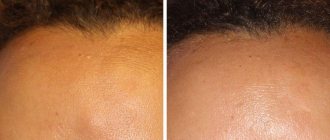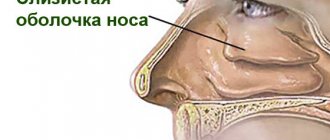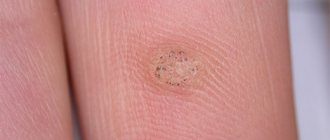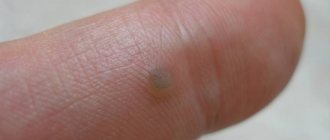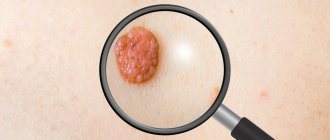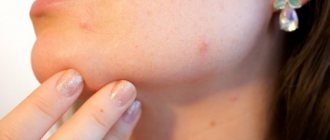Papilloma has turned black - a fairly common complaint that can be heard from patients visiting a dermatologist’s office.
Most people with these benign skin growths know that they can become malignant.
Therefore, they treat any changes with great caution.
Naturally, a change in color inevitably causes not only caution, but also well-founded fears.
Why benign formations can turn black, and what symptoms this can be combined with, patients are often interested in.
What tests should I undergo to make sure there is no danger to life, and what are the possible consequences?
Is it dangerous to change the appearance of papilloma?
The human papillomavirus provokes the appearance of new growths on the skin. They differ in size, shape, color.
Dermatologists note that growths located in places of constant injury must be under constant supervision.
In some cases, they should be removed to eliminate the risk of negative consequences.
A change in appearance is one of the signs of the onset of the development of a pathological process. Additionally, a person experiences other characteristic signs of infection:
- sudden change in color: may turn black or blue;
- active expansion of education;
- a constant feeling of discomfort in the affected area, even at rest;
- emerging pain of a pulsating nature;
- purulent, sanguineous discharge from papilloma;
- putrid smell.
Each of the symptoms is a warning sign. Self-medication is prohibited. Concerns home remedies of traditional medicine, burning with celandine. It can cause warts to become infected and contribute to the development of the inflammatory process.
Necessary tests and examinations
Today, there are many accurate methods for detecting the papilloma virus in the human body and determining its potential danger. The most common examinations are:
- Analysis for papillomavirus using polymerase chain reaction to detect viral DNA. In this case, the type of papillomas, their quantity and quality in the body (for example, oncogenic viruses) are recognized.
- Biopsy with histological examination of tissue for cancerous degeneration.
- General clinical tests.
- Cytological studies.
- Digene-test. Determination of oncogenicity and concentration of pathogenic formation.
- Ultrasound and colposcopy.
The difference between a darkened mole and papilloma
It is difficult for a non-specialist to find the differences between a papilloma and a mole. There are several signs that allow you to determine the type of education yourself.
| Papilloma | Mole | |
| 1. | It is distinguished by its looseness and soft structure. | Dense and hard. |
| 2. | Consists of connective tissue covered by skin | Moles are made up of skin cells. |
| 3. | Localized in the area of skin folds: groin, eyelids, neck, armpits. Condylomas grow in the anus and genital area. | They spread mostly over the limbs, back, face, torso, and appear on the stomach. |
| 4. | They are distinguished by an asymmetrical shape. | Has clear boundaries. |
| 5. | The appearance is torn, uneven, growths protrude above the surface of the skin. | Externally smooth and even. |
| 6. | The color ranges from light to dark. | The color remains the same. |
| 7. | Appear after infection with HPV. There is an increase in size. | Growth is absent or slow. Moles of the same size and location can be transmitted at the genetic level. |
A mole in normal condition does not bother you with burning, itching, or itching. All these signs are characteristic of growths that become malignant.
Removal of blackened papillomas
What to do if the tumor is very disturbing? It's better to remove it. There are a huge number of possible options for removing papillomas, both blackened and benign.
Conventional excision
This method of treating malignant blackened papillomas involves excision of the tumor with a portion of healthy tissue. The operation is performed under local anesthesia and takes 10-15 minutes. The vessel from which the tumor grew and fed is cauterized using electrocoagulation. The postoperative wound is treated with an antiseptic.
Laser surgery
Laser removal of the growth can be carried out if there is no inflammation around the tumor. The area of the body where the papilloma is located is anesthetized, after which they begin to burn out the papule along with the root. A very effective method of treating benign neoplasms.
Cryodestruction
Treatment of warts is carried out using cold through cryodestruction. A dermatologist treats the papilloma with liquid nitrogen for 5-15 seconds. Liquid nitrogen is supplied to the skin formation through a cryoprobe, the temperature of which is –196 degrees. Nitrogen freezes the papilloma cells and they are destroyed. After removal, the site turns white, skin redness and swelling occur, a blister and soreness appear. For a week, the wound is treated with boric acid twice a day. After 4 days, the bubble bursts, and in its place a crust forms, which closes the wound.
Radiosurgery
The most gentle removal method. The surgical field is treated with an anesthetic and the papilloma is cut off at the root using a radio knife. Removal is painless, there is no risk of infection, since the instruments do not touch the wound.
Electrocoagulation method
Removal of formation using electric current of a certain frequency. The electrocoagulator dries out the narrow base or the entire papilloma, after which the growth is easily removed. Bleeding can be prevented, since the vessels are cauterized along with the growth. Rehabilitation is completed in 7-10 days. During this period, you need to treat the wound with calendula tincture two to three times a day.
Drug treatment
After removing warts, it is imperative to undergo drug treatment, since HPV is not only located at the site of papule formation - it constantly lives in the body and waits for the moment when the immune system weakens. Therefore, therapy must be comprehensive.
- antiviral therapy - oral tablets are prescribed that prevent the virus from multiplying;
- immunostimulants in the form of tablets and drops – strengthen the body’s defenses;
- complex vitamins.
Causes of darkening
If black papilloma is observed, the cause should be identified. Experts identify factors that provoke such a change:
- emerging inflammation, infection;
- injury;
- rubbing with clothes, shoes;
- consequences of self-removal, burning with traumatic compounds of vinegar, alkaline mixtures;
- darkening occurred after taking certain medications. Dries out and may fall off on its own;
- improvement of the immune system - suppression of HPV, papillomas turn black and disappear;
- hemangioma formation.
The result of unconventional methods of removing formations may be its blackening.
If there are no accompanying alarming symptoms, there is no need to worry. After some time, the wart will fall off on its own, leaving no traces.
Features of accompanying symptoms
Papillomavirus, activated in the body, manifests itself as numerous growths. Men and women should be closely monitored for such formations when they occur at sites of injury.
Genital warts that occur in the genital area and anus are more at risk of constant rubbing; they can be injured during hygiene procedures and sex. Increases the risk of malignancy; such elements should be removed in a timely manner, after consulting with a dermatologist or oncologist.
Has dried up
If the papillomas darken, begin to dry out, but do not fall off, an examination by a specialist is recommended.
To identify the cause of this condition, a person undergoes the necessary tests. The dermatologist prescribes treatment.
In some cases, removal is recommended. You cannot do it yourself; the use of folk remedies can cause an inflammatory process. In the hospital, the doctor will select the optimal destruction method, eliminating the risk of adverse reactions and possible relapse.
Additionally, a person should take immunostimulating drugs, activating the body's defenses. It will help suppress HPV, the warts will begin to dry out, gradually disappearing.
Hurts
In a normal state, the formations do not hurt. In case of infection and the onset of a pathological process, discomfort occurs inside the element. At first it may be felt exclusively during palpation. As the situation worsens, the pain does not go away even at rest.
Soreness can manifest itself as a consequence of constant injury from clothing. Concerns genital warts. Their tips constantly rub against underwear and can bleed. Requires immediate medical intervention.
The papilloma requires removal, it has turned black and hurts, and has begun to break out.
Similar sensations appear after self-cauterization of formations with aggressive compounds, celandine juice, and vinegar at home. Untested traditional medicine can cause harm; if the formations turn black and hurt, you should go to the hospital.
Inflamed
Need advice from an experienced doctor?
Get a doctor's consultation online. Ask your question right now.
Ask a free question
The inflammatory process is provoked by injuries received during hygiene and water procedures. The integrity of the nodules is disrupted, and pain occurs. Most injuries occur in the groin or armpit area. Careless shaving, rubbing with clothes, and tearing while changing clothes cause damage. If the situation repeats itself constantly, inflammation cannot be avoided. Thread-like growths on the neck, rubbed by collars and jewelry, are often subject to unwanted effects.
During inflammation, the element increases in size, festers, and bleeds. There is persistent redness of the formation surrounding the skin. An increase in temperature is possible. A thick brown crust appears on the area.
Self-medication is prohibited. It is necessary to undergo a doctor's examination and take tests. After diagnosis, the necessary therapy is selected or removal is prescribed.
fell off
If the papillomas turn black and dry, and then fall off, the condition may indicate tissue necrosis. Occurs after successful treatment and strengthening of the immune system.
The affected area should be treated with an antiseptic to prevent infection. Consultation with a doctor is not necessary if there are no disturbing symptoms. If there is redness, an inflammatory process has begun, or pain has arisen, you cannot delay a visit to a dermatologist.
Doctors recommend that patients save the fallen growth and submit it to the laboratory for histological examination. Establishes the nature of education, eliminating the risk of negative consequences.
Possible consequences
Possible consequences of accidentally removing warts are:
- Bleeding. Typically, warts are richly vascularized and well supplied with blood. Therefore, during trauma, damage to blood vessels is possible.
- Risk of secondary infection. In this case, an abscess, phlegmon, and suppuration of soft tissues may form.
- The formation of a noticeable scar or scar at the site of the former wart.
- Further spread of papillomas. If the roots are not removed sufficiently, one or more larger warts may grow at the site of the damaged formation.
- Degeneration into a malignant tumor. If a formation with a dark surface, reminiscent of cauliflower in appearance, and bleeding appears at the site of the growth, this is an unfavorable prognostic sign.
If the papilloma has dried out, turned black and fallen off, you should consult a doctor for a histological examination. Determining the type of tumor is necessary for further treatment tactics. Adequate therapy will help get rid of unaesthetic rashes or improve the prognosis when malignant pathology is detected.
Treatment of black papilloma
Doctors of different specialties can treat papillomas that have changed color.
- A dermatologist and surgeon remove foreign elements from open areas of the body using cryodestruction (freezing with liquid nitrogen) and laser removal. Surgical excision is recommended if malignancy is suspected.
- For formations on the oral mucosa, the help of a dentist is needed.
- If it is located on the genitals or anus, removal is carried out by a gynecologist or proctologist.
- Men with condylomas turn to a urologist.
- The help of an ophthalmologist is necessary when diagnosing foreign elements on the eye.
- Women turn to an oncologist-mammologist when a growth forms on the mammary gland or nipple. It may not cause problems, but requires monitoring during pregnancy. This also applies to menopause. A sharp change in hormonal levels leads to blackening of the formations. During lactation, the child is at risk of becoming infected.
Many people do home treatment using traditional medicine recipes and proven pharmaceutical products. Antipapilloma gel is used without a doctor’s prescription; it copes with small flat warts and gives a positive result after just a couple of days. They begin to dry out and fall off, leaving no traces.
Oxolinic ointment 3% is an effective antiviral agent. It copes with the external manifestations of HPV, but does not affect the virus itself. Should be taken into account during treatment.
What to do with warts
They need to be treated. But before you start treatment, you should definitely visit a good dermatologist. He will be able to study in detail the picture of what is happening, assess the existing problems and prescribe the optimal course of treatment.
- If the growth has already turned black, but no harmful processes such as inflammation, suppuration or bleeding occur, the dermatologist will advise you to simply wait or speed up the process by applying special products to the growths;
- In some cases, you just need a little help from the immune system as your only weapon in the fight against the virus. For these purposes, the doctor prescribes topical agents, or tablets to enhance immunity and antiviral drugs;
- If blackening is the result of injury, it is better to remove the tumor immediately. As optimal methods of removal, it is recommended to use laser coagulation, radio wave excision, or cryodestruction - freezing the papilloma using liquid nitrogen;
- After removal, the treated areas of skin require certain care and monitoring of the normal course of the healing process. Therefore, do not forget to periodically treat, apply the products prescribed by your doctor and continue the course of antiviral therapy.
Blackened growths are not always a reason to panic. The behavior of papillomas must be constantly monitored until they disappear completely. You should not rely only on your own immune system. It is better to help her with this by visiting a dermatologist and taking the medications prescribed by him. When the situation with papillomas is potentially dangerous, or blackened growths cause you psychological discomfort, it is better to carry out the procedure for their removal.



